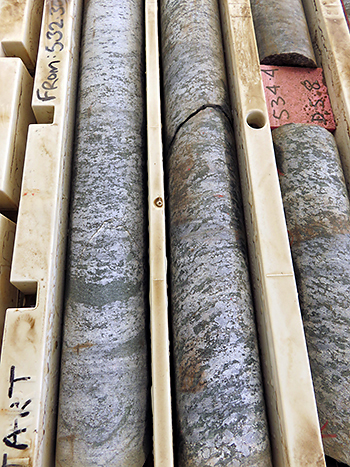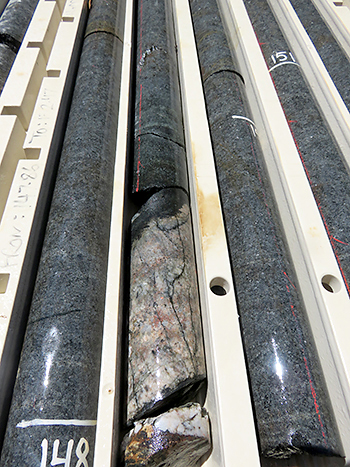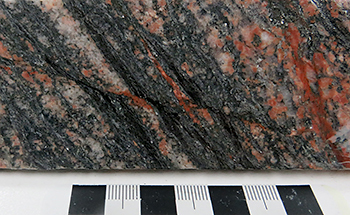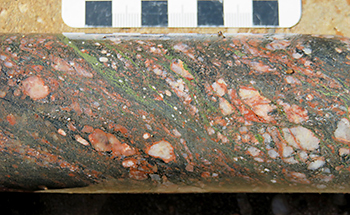Anthony Reid
Geological Survey of South Australia, Department for Energy and Mining
Download this article as a PDF (3.8 MB); cite as MESA Journal 91, pages 26–32
Published October 2019
Introduction
Figure 1 Location of the western Gawler Craton showing the major geophysical/geological domains including the Fowler Domain. Background image is 1:2 million surface geology.
The western Gawler Craton is a frontier region for mineral exploration and geoscientific understanding. The veneer of Cenozoic sediment that overlies crystalline basement is the key reason for the poor understanding of the geology of this region (Fig. 1). Teasdale (1997), Daly, Fanning and Fairclough (1998) and Ferris, Schwarz and Heithersay (2002) provided some of the first detailed descriptions of the Fowler Domain in the western Gawler Craton. The key feature of this domain they identified was the linear aeromagnetic signatures indicative of a belt of intensely deformed rocks. Drilling in the Fowler Domain by the Geological Survey of South Australia revealed an abundance of meta-igneous lithologies or mafic and felsic origin (e.g. Daly and Martin 1989; Daly et al. 1994; Morris, Hill and Ferris 1994). More recently, exploration drilling by Western Areas Ltd in the Fowler Domain has identified further examples of mafic–ultramafic intrusive rocks, including olivine gabbro-norites (Western Areas 2018). Together, the drilling campaigns have shown the region’s potential for intrusion-related nickel and associated base metal and structurally associated, hydrothermal gold mineralisation, although economic mineral occurrences are yet to be located in the crystalline basement (e.g. Daly, Fanning and Fairclough 1998; Constable, Fairclough and Gum 2005; Western Areas 2018).
This paper provides a brief review of new geochronology and metamorphic data recently collected from the Fowler Domain (Jagodzinski, Reid and Gribbin 2019; Reid, Halpin and Dutch 2019). Due to a paucity of geochronology, the internal lithostratigraphy of the Fowler Domain is poorly defined compared to other regions of the Gawler Craton. These new data reveal that the Fowler Domain can be subdivided into two main regions that have unique geological histories. These findings provide insights that will aid in understanding the evolution of the Gawler Craton and help to understand the mineral potential of the Fowler Domain.
Fowler Domain
The Fowler Domain comprises a northeast-trending arcuate high magnetic intensity region in the western Gawler Craton that is in interpreted to be a belt of igneous and metamorphic rocks, with a subordinate component of metasedimentary rocks (e.g. Daly, Fanning and Fairclough 1998; Ferris, Schwarz and Heithersay 2002; Reid and Dutch 2015). The Coorabie Shear Zone bounds it from the Nuyts Domain to the east. The Nuyts Domain is a region dominated by igneous intrusions of the St Peter Suite, Hiltaba Suite and related Munjeela Suite (Payne, Reid et al. 2010; Reid, Pawley et al. 2019). The northern boundary of the Fowler Domain with the Christie Domain is defined based on a change in magnetic character that is interpreted to reflect the location of high magnetic intensity granites adjacent to low magnetic intensity gneisses of the Christie Domain. The western boundary of the Fowler Domain is a similar magnetic intensity contrast to the northern boundary, but is also the location of the Tallacootra Shear Zone, a major, crustal-scale shear zone that extends to the north and reworks part of the Christie Domain (Fig. 1).
Internally, the Fowler Domain is cut by a series of anastomosing northeast-trending shear zones that are evident as linear zones of magnetite-destruction. Where these shear zones crop out at key localities such as Lake Tallacootra, they correspond to poly-deformed felsic gneisses, with structural elements, such as moderate-plunging mineral stretching lineations, interpreted to indicate transpressional deformation (Stewart and Betts 2010). Crustal-scale seismic data and interpretations, along with potential field geophysical inversions, suggest that these shear zones form a series of west-dipping structures, many of which extend to the Moho (Thomas, Direen and Hand 2008; Stewart and Betts 2010; Doublier et al. 2015; van der Wielen et al. 2015).
These shear zones formed the basis on which Teasdale (1997) subdivided the Fowler Domain into four blocks, from west, Colona, Barton, Central and Nundroo. These names have been used by numerous authors subsequently and form a convenient way of isolating distinct sub-regions within the Fowler Domain (e.g. Direen et al. 2005). However, in this paper these names are not used so as to shift the focus to the lithostratigraphy of the region. Instead the Fowler Domain is divided into west and east, with the Chimpering Shear Zone (new name assigned by Doublier et al. 2015) considered the demarcation between these two regions (Fig. 2). These regions are indicated in Figure 3, in which available geochronology from the Fowler Domain is also shown.
Drilling in the Fowler Domain has revealed a range of igneous rock types including cumulate gabbro, tonalite, granodiorite and granite (e.g. Daly and Martin 1989; Morris, Hill and Ferris 1994; Daly, Fanning and Fairclough 1998). In addition, aluminous, sillimanite- and garnet-bearing gneisses are also present, many of which have been interpreted to be derived from metasedimentary protoliths (Daly, Fanning and Fairclough 1998; Howard et al. 2011).
Figure 3 Summary of U–Pb geochronology data available for the Fowler Domain. (a) Magmatic crystallisation and maximum depositional ages. (b) Metamorphic ages. In both (a) and (b), each sample point is indicated as being from either 2019 studies (Jagodzinski, Reid and Gribbin 2019; Reid, Halpin and Dutch 2019) or from previous studies (Teasdale 1997; Fanning, Reid and Teale 2007; Howard et al. 2011; Fraser, Reid and Stern 2012; Reid and Dutch 2012; Reid 2015; Jagodzinski and Reid 2016).
In the western region of the Fowler Domain, west of the Chimpering Shear Zone, the late Archean to earliest Paleoproterozoic Mulgathing Complex crops out in the vicinity of Lake Ifould (Fig. 3; Teasdale, 1997; Payne, Ferris et al. 2010; Stewart and Betts, 2010). The western portion of the Fowler Domain also has a series of Paleoproterozoic intrusions such as gabbro emplaced at 1727 ± 8 Ma (drillhole COL 43D, SA Geodata drillhole no. 137323; Fanning, Reid and Teale 2007), granite and deformed granite emplaced at c. 1690 Ma, part of the Tunkillia Suite (Ferris and Schwarz 2004; Fanning, Reid and Teale 2007). Furthermore, zircon ages of between 1760 and 1700 Ma in garnet-bearing gneisses were interpreted to be maximum ages of deposition of interpreted sedimentary protoliths (Howard et al. 2008; Howard et al. 2011). These studies also reported co-existing metamorphic monazite with ages c. 1690–1670 Ma, thereby constraining the age of deposition to be immediately prior to, or synchronous with, the major Gawler Craton tectonometamorphic event known as the Kimban Orogeny (Howard et al. 2008; Howard et al. 2011).
Post-Kimban Orogeny, younger rocks are known in the eastern Fowler Domain, in particular, the St Peter Suite and Hiltaba Suite (Figs 2, 3). In the case of the St Peter Suite, rocks include metamorphosed quartz diorite and garnet-bearing quartzo-feldspathic gneiss intersected in Nundroo 2 and 3 drillholes dated at 1607 ± 6 Ma and 1616 ± 5 Ma (SA Geodata samples 2115496 and 2115514 respectively; Jagodzinski and Reid 2016). Examples of Hiltaba Suite granites in the Fowler Domain include foliated granites emplaced at 1586 ± 9 Ma and 1568 ± 11 Ma (samples 215773 and 215780 respectively; Fanning, Reid and Teale 2007). Interestingly, the latter sample also preserves inherited zircon with ages of c. 1690 Ma and c. 1620 Ma.
The Fowler Domain also has a Mesoproterozoic deformation and metamorphic history. Thomas, Direen and Hand (2008) presented reconnaissance electron microprobe chemical monazite ages between c. 1650 and 1580 Ma, suggesting metamorphism sometime in the late Paleoproterozoic to early Mesoproterozoic in the Fowler Domain. Fanning, Reid and Teale (2007) reported metamorphic ages of 1547 ± 9 Ma from mafic gneiss in drillhole Nundroo 2 DDH. Post-tectonic, undeformed pegmatite from the drillhole Nundroo 2 DDH was emplaced at 1489 ± 4 Ma (Fanning, Reid and Teale 2007). Regional 40Ar/39Ar data from foliation-defining biotite in deformed granites of the western Fowler Domain suggest recrystallisation due to deformation occurred at c. 1450 Ma (Fraser and Lyons 2006), suggested to be part of a period of reworking that Hand, Reid and Jagodzinski (2007) termed the Coorabbie Orogeny.
Summary of recent geochronology and metamorphic analysis
A program of sensitive high resolution ion microprobe (SHRIMP) zircon U–Pb geochronology was undertaken recently in collaboration with Western Areas (Jagodzinski, Reid and Gribbin 2019) and is summarised below. In addition, a recent program of monazite geochronology and metamorphic analysis is likewise summarised (Reid, Halpin and Dutch 2019).
Drillhole WGD001 in the western Fowler Domain, west of the Chimpering Shear Zone, intersected metagranite and metagabbro along with pyroxenite (Fig. 4). Intermingling textures between the felsic and mafic lithologies in this drillhole suggest they are likely to be comagmatic. A sample of the metagranite yielded a single magmatic population of zircons with an age of 1730 ± 5 Ma (sample 2322230). A sample of metagabbro however, yielded an age of 1697 ± 5 Ma from zircons that appear to be metamorphic in origin. Jagodzinski, Reid and Gribbin (2019) interpret the intrusive complex to have been emplaced at c. 1730 Ma before undergoing metamorphism during the Kimban Orogeny at c. 1697 Ma. This interpretation is consistent with previous magmatic and metamorphic ages from this region of the western Fowler Domain (Fanning, Reid and Teale 2007; Howard et al. 2011).
Figure 4 Examples of rock types from the western Fowler Domain, drillhole WGD001.
4(a) Metagranite. (Photo 417933)
4(b) Metagabbro. (Photo 417934)
Samples of metagranite and felsic gneiss from drill core in the eastern Fowler Domain yield ages between c. 1620 Ma and c. 1580 Ma (Jagodzinski, Reid and Gribbin 2019). These samples include a garnet- and sillimanite-bearing gneiss in drillhole FBD2 (sample 2322236; Fig. 5a), which yielded ages from zircon cores of 1650 ± 5 Ma and 1612 ± 5 Ma, with ages of c. 1775 Ma, 1750 Ma and 1690 Ma also occurring in individual grains. There are two possible interpretations for this age spectra. Firstly, it could be a metasedimentary rock, with the youngest age, 1612 ± 5 Ma, providing the maximum age of deposition of the protolith. Secondly, the protolith could be an igneous rock of the St Peter Suite that contains a significant component of zircon inheritance. This sample also contains zircon rims of metamorphic origin that have an age of 1585 ± 4 Ma (Jagodzinski, Reid and Gribbin 2019).
A sample of a hornblende-bearing hematite and epidote/chlorite altered granite (Fig. 5b) from a nearby drillhole, FBD1, yielded an emplacement age of 1578 ± 9 Ma (Jagodzinski, Reid and Gribbin 2019). This emplacement age is similar to the timing of metamorphism identified in the nearby drillhole FBD2.
Figure 5 Examples of rock types from the eastern Fowler Domain.
5(a) Garnet-, sillimanite- and muscovite-bearing metagranite in drillhole FBD2. (Photo 417935)
5(b) Hematite- and epidote-altered metagranite from drillhole FBD1. (Photo 417936)
Garnet- and sillimanite-bearing quartzofeldspathic gneiss in drillhole WGAC0105 located less than 10 km east of the Chimpering Shear Zone and, in the terminology of this article, part of the eastern Fowler Domain (Fig. 3), yielded a single age population of 1586 ± 3 Ma, suggesting this gneiss is a metamorphosed pluton of the Hiltaba Suite (sample 2145321; Jagodzinski, Reid and Gribbin 2019).
The data from drillholes FBD1, FBD2 and WGAC0105 suggests that in this region of the eastern Fowler Domain, Hiltaba Suite granites were emplaced into the St Peter Suite. Similar geological relationships are known from the Nuyts Domain, to the east of the Fowler Domain (e.g. Pawley, Reid and Dutch 2016; Reid, Pawely et al. 2019), although the degree of deformation and metamorphism of St Peter Suite and Hiltaba Suite granites in the Nuyts Domain is minimal in comparison with that recorded in the Fowler Domain.
The metamorphic evolution of the Fowler Domain also supports the notion that the western and eastern portion of the Fowler Domain preserve a distinct geological evolution (Teasdale 1997; Thomas, Direen and Hand 2008; Reid, Halpin and Dutch 2019). In the western Fowler Domain, pelitic gneisses record metamorphism during the Kimban Orogeny at c. 1710 to 1690 Ma, with peak conditions of ~8 kbar at 800 °C (Reid, Halpin and Dutch 2019). In contrast, aluminous quartzofeldspathic gneiss of the eastern Fowler Domain in drillhole Nundroo 2 DDH underwent high-grade metamorphism at peak conditions of ~7 kbar at 800 °C at around 1590 Ma (Reid, Halpin and Dutch 2019), with similar to metamorphic conditions inferred by Thomas, Direen and Hand (2008) for this region. These early Mesoproterozoic pressure–temperature conditions suggest the rocks were locally buried to depths of approximately 20–25 km. Furthermore, it is important to recognise that this metamorphism was occurring at around the same time as the extrusion of the Gawler Range Volcanics and emplacement of the Hiltaba Suite across much of the Gawler Craton.
Discussion
The key outcome of the new data from the Fowler Domain is recognition that the western Fowler Domain, the region west of the Chimpering Shear Zone, comprises reworked Tunkillia Suite and Archean basement and was deformed and metamorphosed during the Kimban Orogeny. In contrast, the eastern Fowler Domain appears to be dominated by reworked St Peter Suite and Hiltaba Suite, with local evidence for high-temperature metamorphism occurring during the early Mesoproterozoic Kararan Orogeny. The boundary between these two broad regions of the Fowler Domain appears to correspond, approximately, to the Chimpering Shear Zone (Doublier et al. 2015).
Rather than being viewed as a single, uniform domain, it appears that the Fowler Domain comprises at least two regions of contrasting lithostratigraphic composition. The results suggest that the eastern Fowler Domain represents a region of equivalent lithostratigraphy to that of Nuyts Domain that was reworked during Mesoproterozoic deformation and local high-grade metamorphism. Consequently, while the eastern edge of the currently proposed Fowler Domain does appear to be a significant boundary on the aeromagnetic images, the Chimpering Shear Zone may be a more significant boundary in terms of the overall lithostratigraphic composition and structural evolution of the region.
Future work
With the newly available Gawler Craton Airborne Survey aeromagnetic data (regions 4A and 4B; Foss et al. 2019b; Foss et al. 2019a), future work in the Fowler Domain region will include an update of the solid geology interpretations to more accurately reflect the composition and location of different units. The St Peter Suite appears to be moderately to highly magnetic, whereas in the eastern Fowler Domain at least, the Hiltaba Suite appears to have relatively lower magnetic intensity that may enable detailed mapping of the different suites across the eastern Fowler Domain. At present we have a limited isotopic dataset from the Fowler Domain (e.g. Howard et al. 2011; Reid and Payne 2017). Future work would also aim to characterise the Sm–Nd and Lu–Hf compositions of the igneous rock units described in the recent geochronology programs to further understanding the petrogenesis of mafic and felsic rocks of the Fowler Domain.
Acknowledgements
Western Areas, in particular Graeme Gribbin and Ian Gregory, are thanked for initiating the geochronology program described in Report Book 2019/ 00018 and reviewed here. Jacqui Halpin (University of Tasmania) provided significant contribution to understanding the metamorphic evolution of the western Gawler Craton. Mark Pawley provided a helpful review of this article.
References
Constable S, Fairclough MC and Gum J 2005. Nickel mineralisation models in the Fowler Domain and Musgrave Province - applying the Thompson Nickel Belt as an analogue. Minerals and Energy South Australia Journal 39:14–21.
Daly SJ, Fanning CM and Fairclough MC 1998. Tectonic evolution and exploration potential of the Gawler Craton, South Australia. AGSO Journal of Australian Geology & Geophysics 17:145–168.
Direen NG, Cadd AG, Lyons P and Teasdale JP 2005. Architecture of Proterozoic shear zones in the Christie Domain, western Gawler Craton, Australia: geophysical appraisal of a poorly exposed orogenic terrane. Precambrian Research 142(1-2):28–44.
Ferris GM, Schwarz MP and Heithersay P 2002. The geological framework, distribution and controls of Fe-oxide Cu-Au mineralisation in the Gawler Craton, South Australia. Part I – Geological and tectonic framework. In TM Porter ed, Hydrothermal iron oxide copper-gold and related deposits: a global perspective, vol. 2. PGC Publishing, Adelaide, pp. 9–31.
Fraser G and Lyons P 2006. Timing of Mesoproterozoic tectonic activity in the northwestern Gawler Craton constrained by 40Ar/39Ar geochronology. Precambrian Research 151:160–184.
Fraser G, Reid A and Stern R 2012. Timing of deformation and exhumation across the Karari Shear Zone, north-western Gawler Craton, South Australia. Australian Journal of Earth Sciences 59:547–570.
Hand M, Reid A and Jagodzinski E 2007. Tectonic framework and evolution of the Gawler Craton, South Australia. Economic Geology 102:1377–1395.
Howard KE, Hand M, Barovich KM, Payne JL and Belousova EA 2011. U-Pb, Lu-Hf and Sm-Nd isotopic constraints on provenance and depositional timing of metasedimentary rocks in the western Gawler Craton: implications for Proterozoic reconstruction models. Precambrian Research 184:43–62.
Payne JL, Ferris G, Barovich KM and Hand M 2010. Pitfalls of classifying ancient magmatic suites with tectonic discrimination diagrams: an example from the Paleoproterozoic Tunkillia Suite, southern Australia. Precambrian Research 177:227–240.
Reid AJ, Halpin JA and Dutch RA 2019. Timing and style of high-temperature metamorphism across the western Gawler Craton during the Paleo- to Mesoproterozoic. Australian Journal of Earth Sciences.
Reid AJ and Payne JL 2017. Magmatic zircon Lu–Hf isotopic record of juvenile addition and crustal reworking in the Gawler Craton, Australia. Lithos 292-293:294–306.
Stewart JR and Betts PG 2010. Implications for Proterozoic plate margin evolution from geophysical analysis and crustal-scale modeling within the western Gawler Craton, Australia. Tectonophysics 483:151–177.
Teasdale J 1997. Methods for understanding poorly exposed terranes: the interpretive geology and tectonothermal evolution of the western Gawler Craton. PhD thesis, University of Adelaide.
Thomas JL, Direen NG and Hand M 2008. Blind orogen: integrated appraisal of multiple episodes of Mesoproterozoic deformation and reworking in the Fowler Domain, western Gawler Craton, Australia. Precambrian Research 166:263–282.
Western Areas Ltd 2018. Annual report 2018. ASX Limited, viewed 5 September 2019.









